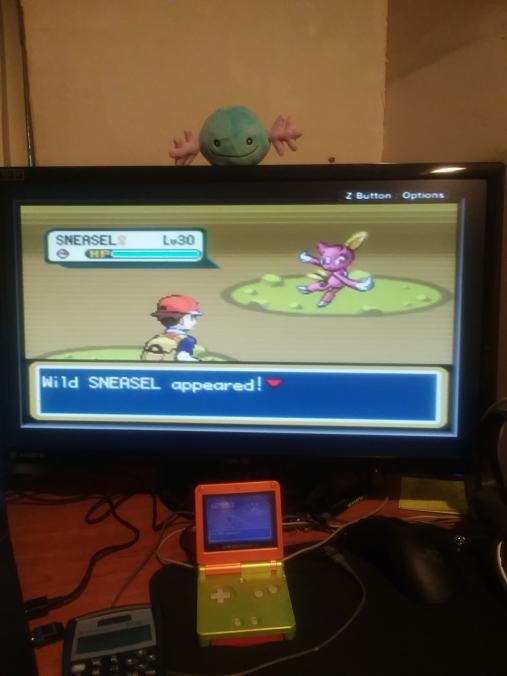Since generation 3 of the Pokémon games (with the exception of the 5th generation) there have been a fair amount of ribbons to collect. These ribbons persist during transfers and as of recent (the past 4 years) they’ve actually meant something because they are partially equippable, giving whatever Pokémon has earned them a neat title whenever they get sent out. The result of this is that you can quite literally have a Pokémon that is decades old (March of this year marks 20 years for the first gen 3 games!) with ribbons that were obtained all the way back in Ruby and Sapphire.
This mechanic opens up a lot of interesting scenarios and combinations to which I spend a lot of time either obtaining or at the very least thinking about. Take for example all of the shadow Pokémon that get a special ribbon from Colosseum/XD. For those unaware, there’s a special ribbon that shadow Pokémon get after they are purified that no other game awards. Because of this, this is more or less a marker that acts as a signal to other players that ‘yes, this specific Pokémon came from a spin-off game that could trade with the main generation 3 games to which I have transferred up all this time’. Just having the ability to do that is wild, but the execution of it allows for some even rarer scenarios.
Take for example Dunsparce. It was a shadow Pokémon in Colosseum. I believe it was obtainable in Pyrite Cave if my memory servers correctly. Well, Scarlet and Violet of generation 9 saw Dunsparce get a new evolution after all of this time. It would be entirely possible to transfer from Colosseum to Scarlet/Violet only to evolve Dunsparce and essentially have a generation 3 ribbon on a generation 9 Pokémon. There are other Pokémon like this, off the top of my head Quilava, Ursaring, Scyther, Stantler, Misdreavus, Sneasel and Murkrow are all Pokémon that can be caught in Colosseum/XD and can be transferred up into games with new evolutions. There are definitely more, but I can only speak on behalf of Colosseum and not XD (have yet to 100% XD yet for the second time, first time I did I was young and did not keep the shadow Pokémon together).
Another aspect of this is the fact that you can have dedicated Ribbon Masters. There is a small community of people out there that decided to catch a Pokémon and get literally every single ribbon available. I don’t really see too much utility in that because at the end of the day, it’s just another number that goes up with you hardly ever using most of the ribbon titles, but it’s an option. I do have a level 100 Wooper that has every single ribbon obtainable from gen 6 onwards minus the two harder Battle Maison/Tree ribbons, but I find myself often times using only two or three specific ribbons like the Rank Master Ribbon, the Gorgeous Royal Ribbon or the Skillful Battler Ribbon. Ribbons mainly act as an achievement type of system, where they show that you did something. Unfortunately, many of the tasks are mundane, like clearing the Elite Four with a specific Pokémon in your party or getting 999,999 dollars for a specific ribbon. But others have some weight to them, namely the tower ribbons.
The combination of getting ribbons and shiny hunting may be the ultimate test in collection and patience. I am not really much of a shiny hunter because I don’t think the palette swap justifies forgoing so many other details, like natures or stats but there was exactly one Pokémon I shiny hunted and got a special ribbon on.

This is my rarest non-event Pokémon. In generation 3, Sneasel was already one of the rarest Pokémon to get. It was a 5% chance encounter for the species in only LeafGreen in Icefall Cave, explicitly a postgame location, with the original (and really the best) shiny odds of 1/8192 for every encounter. I had planned it to be a hunt that would have taken me an entire summer because the odds were so low. But for some reason, I got it in a weekend in only 1706 encounters. I have no idea how it happened, but the idea after that was to get the Mt. Battle ribbon from Colosseum to give it the 100x Victorious title in Sword/Shield. I did that and the result is a Pokémon that I may be so bold to even say simply doesn’t exist anywhere else in the entire world. Yes, I may be exaggerating that a bit, but the end result is something you do not see every day. I also evolved it into a Weavile since it adds to the ‘rarity factor’ as it is a gen 4 Pokémon with a gen 3 ribbon.
A new aspect of the game as of Sword/Shield are marks. I wouldn’t be able to be content with this post without mentioning marks. Essentially, they are ribbons but they are tied to the conditions of the capture instead of the achievements of a Pokémon. A prime example of this is getting a mark for catching a Pokémon while it is snowing. They give a bit more of a rarity factor for catches and are a perfect alternative to the overdone and flooded state of shinies. There are a few types of marks, like the personality marks (which are a 1/100 chance on all wild Pokémon and to which there are a ton of these marks that a Pokémon can end up with- hunting a specific one here would be even harder than a shiny Pokémon), the weather marks (1/50), and the time of day marks (not sure the odds on these, but these are the most common). There are others and I’m not going to explain all of them, but there are three marks that are only obtainable in Sword/Shield that are not in Scarlet/Violet. These marks are for catching Pokémon when fishing, getting wild Pokémon from making curry, and catching Pokémon in dense fog. With the aforementioned scenario of Pokémon that evolve in later gens, you can get exactly one new Pokémon from gen 9 with the curry mark: Kingambit. Dudunsparce may be available with the special mark that can be obtained on Pokémon in dense fog, but who is to say that fog won’t eventually make its way back into SV?
With Bank shutting down in the future (and with how tedious it is to transfer all the way up), I think it’s more important than ever to highlight some of these Pokémon that will eventually be lost to time. I’m certainly not planning on playing the series my entire life, but it seems clear that in some aspects you will be able to bring Pokémon up to the most recent generation from the last. I think that as a collector that has already completed the National Dex and as someone who doesn’t care about shinies anymore, this route for filling the collection itch is probably the best one yet due to how obscure and at times how tedious it can be. At the end, you will have something that will make you feel accomplished until you realize that at the end of the day this is a video game and that it has no weight, bearing or value to your actual life, to which you then have to have cold and crushing reality set in that you spent hours trying to get it all while there are people that actually do what they are supposed to be doing and are hitting tangible life goals like starting a family or making a certain amount of money so that they can then do what they want with no issue, which you cannot do because you are not even putting in the minimum amount of effort to do.
